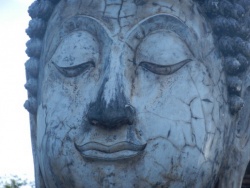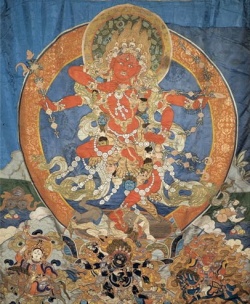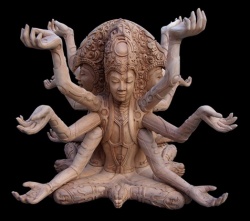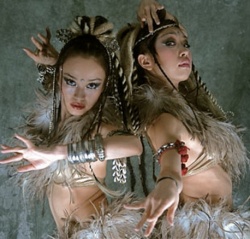Dorje Pakmo
In Tibetan Buddhism, Dorje Pakmo (Tibetan: བསམ་སྡིང་རྡོ་རྗེ་ཕག་མོ་སྤྲུལ་སྐུ།, Wylie: bsam-sding rdo-rje-phag-mo sprul-sku, ZYPY: Samding Dojêpagmo Zhügu, literally The Diamond Sow; simplified Chinese: 桑顶多吉帕姆活佛 (多杰帕嫫); traditional Chinese: 桑頂多吉帕姆活佛 (多傑帕嫫); pinyin: Duōjí Pàmǔ (Duōjié Pàmó); Sanskrit: Vajravārāhī), also known as Sera Kandro, is believed to be the reincarnation of the consort of the wrathful deity Demchok (Heruka).
She is the highest female incarnation in Tibet and the third highest-ranking person in the hierarchy after the Dalai Lama and the Panchen Lama.
She was listed among the highest-ranking reincarnations at the time of the Fifth Dalai Lama, recognized by the Tibetan government and acknowledged by the emperors of Qing China.
History and background
Her seat, Samding (literally, 'the temple of soaring meditation') was in many ways unique in that about half of the inhabitants were monks and the other half were nuns, while the head of the monastery with all its branches was (and still is) a woman.
It is a Geluk Ani gompa (or nunnery) – which also housed some monks – and was built on a hill on a peninsula jutting into the sacred lake, Yamdrok Tso.
The female tulku who was the abbess of Samding monastery, on the shores of the Yamdrok Tso Lake, near Gyantse, Tibet was traditionally a nirmanakaya emanation of Vajravarahi (Tibetan: Dorje Phagmo).
The lineage started in 15th century with the princess of Gungthang, Chokyi Dronma (Wylie: Chos-kyi sgron-me)(1422–1455).
She became known as Samding Dorje Pagmo (Wylie: bSam-lding rDo-rje phag-mo) and began a line of female tulkus, reincarnate lamas.
She was a contemporary of Gendun Drup (1391–1474) and her teacher Bodong Panchen Chogley Namgyal also was one of his teachers.
Charles Alfred Bell met the tulku in 1920 and took photographs of her, calling her Dorje Pamo in his book.
The current incarnation, the 12th of this line, resides in Lhasa. where she is known as Female Living Buddha Dorje Palma by the Chinese.
- The present incarnation [i.e. in 1882] of the divine Dorje Phagmo is a lady of twenty-six, Nag-wang rinchen kunzag wangmo by name.
She wears her hair long; her face is agreeable, her manner dignified, and somewhat resembling those of the Lhacham, though she is much less prepossessing than she.
It is required of her that she never take her rest lying down; in the daytime she may recline on cushions or in a chair, but during the night she sits in the position prescribed for meditation.
- I learnt that the Dorje Phagmo, or the "Diamond Sow," is an incarnation of Dolma (Tara), the divine consort of Shenrezig (Chenrezig).
In days of old, before the time when the Buddha Gautama appeared, there was a hideous monster called Matrankaru, who spread ruin and terror over all the world.
He was the chief of all the legions of demons, goblins, and other evil spirits; even the devils (raksha) of Ceylon had to become his subjects.
He subdued to his rule not only this world, but the eight planets, the twenty-four constellations, the eight Nagas, and the gods.
By his miraculous power he could lift Mount Ribab (Sumeru) on the end of his thumb.
- Finally the Buddha and gods held council to compass about Matrankaru's destruction, and it was decided that Shenrezig should take the form of Tamdrin ("Horse-neck"), and his consort, Dolma, that of Dorje Phagmo ("the Diamond Sow").
When the two had assumed these forms they went to the summit of the Malaya mountains, and Tamdrin neighed three times, to fill the demon with terror, and Dorje Phagmo grunted five times, to strike terror into the heart of Matrankaru's wife, and soon both were lying prostrated at the feet of the two divinities.
But their lives were spared them, and Matrankaru became a devout follower of the Buddha, a defender of the faith (chos gyong), and was given the name of Mahakala.
In 1716, when the Jungar invaders of Tibet came to Nangartse, their chief sent word to Samding to the Dorjo Phagmo to appear before him, that he might see if she really had, as reported, a pig's head.
A mild answer was returned to him; but, incensed at her refusing to obey his summons, he tore down the walls of the monastery of Samding, and broke into the sanctuary.
He found it deserted, not a human being in it, only eighty pigs and as many sows grunting in the congregation hall under the lead of a big sow, and he dared not sack a place belonging to pigs.
- When the Jungars had given up all idea of sacking Samding, suddenly the pigs disappeared to become venerable-looking lamas and nuns, with the saintly Dorje Phagmo at their head.
Filled with astonishment and veneration for the sacred character of the lady abbess, the chief made immense presents to her lamasery."
- "Her monastery belongs to one of the red hat or unreformed orders, which are frowned on by the prevailing yellow-hat hierarchy, but an exception has been made in her case, and she is treated with royal honors by the Lhasa government, sharing with the Tashi- and Dalai-lamas the privilege of riding in a sedan-chair when she travels.
She is also exempt from the rule that all nuns must shave off their hair and is permitted to wear her hair long, but on the other hand she is never permitted to assume a recumbent position.
In the daytime she can sleep sitting up in a chair, but the whole night she must spend in meditation in the rigorous position demanded in this practice."
Samding gompa was destroyed after 1959 but is in the process of being restored.
Lineage
The first Dorje Phagmo, Chokyi Dronma, was a princess of the then independent kingdom of Gungthang in southwestern Tibet in the 15th century.
She married into the royal family of the principality of Southern Lato that is she married/was married to the prince of southern Lato (La stod lho) defined as a keen supporter of Bonpo practices – but, after the death of her only child, a daughter, she renounced her family and royal status to become a Buddhist nun circa 1442.
- She rapidly became famous as a dynamic and inspirational follower, possibly a tantric consort (phyag rgya ma), of three of the outstanding religious tantric masters of the era.
She was also recognised as a master in her own right and as the spiritual heir of her main teacher.
She contributed to some of the most significant works of art, architecture, and engineering of her time and had seminal influence in the development of printing.
Furthermore, she expressed a particular commitment toward women, promoting their education, establishing nunneries, and even creating religious dances that included roles for them.
Chokyi Dronma died at the age of thirty-three, leaving a tangible mark on history not only through her own deeds but even more through what happened after her death: her disciples searched for the girl in whom she had reincarnated and thus initiated a line of female incarnations that became the first and most famous in Tibet."
Chokyi Dronma was a leading figure in the Tibetan Bodongpa tradition which gradually waned under Gelugpa rule, but is being gradually restored today.
She died at the Manmogang Monastery in Tsari to the southeast of Dakpo, near the Indian border, in 1455. Diemberger also says that [..... "the Venerable Lady passed away into the dakinis' heaven (khecara), her true home.
She left her skull with special features as the wish-fulfilling gem of the great meditation center of Tsagong.
The great siddha Thangtong Gyalpo had said earlier, 'A skull with special features will come to this sacred place, together with a mountain dweller from Ngari', and thus the prophecy had come true, greatly enhancing the devotion of the Kongpo people."]
According to Diemberger the second Dorje Phagmo was Kunga Sangmo (wylie: Kun dga' bzang mo) (1459–1502).
The ninth Dorje Phagmo -Choying Dechen Tshomo-, for example, became a renowned spiritual master not only for Samding but also for the Nyingma tradition, discovered some terma and died at Samye.
Her skull is still preserved and worshipped as a holy relic in the Nyingmapa monastery on the island of Yumbudo in Yamdrok Tso Lake.
In premodern Tibet, the successive incarnations of Dorje Pakmo were treated with royal privilege and, along with the Dalai and Panchen Lamas, (and when they were in Tibet, the Chinese Ambans) were permitted to travel by palanquin or sedan chair.
Unlike most other nuns, Dorje Pakmo was allowed to wear her hair long, but was never to sleep lying down – in the day she could sleep sitting up in a chair, but was expected at night to remain in a meditative position.
The 12th Samding Dorje Pakmo Trülku is Dorje Pakmo Dêqên Qoizhoin Rinpoche, who was born in 1942.
Names
Diemberger writes: "Three names in particular frame her identity according to a classical Tibetan threefold model: as a royal princess she was called Queen of the Jewel (Konchog Gyalmo), her 'outer' name; when she took her vows she became known as Lamp of the Doctrine (Chokyi Dronma), her 'inner' name; as a divine incarnation she was called Thunderbolt Female Pig (Dorje Phagmo), her 'secret' name." The wylie transliteration is given by Diemberger as Chos kyi sgron me.
Also: "The princess's three main names seem to refer to three distinct modes of manifesting herself in different contexts: Konchog Gyalmo (Queen of the Jewel), her birth name; Chokyi Dronma (Lamp of the Dharma), the name she was given when she was ordained as a novice; and Dorje Phagmo (Vajravarahi), the name attributed to her when she was revealed as an emanation of this deity.
In an introductory letter, written by Thangtong Gyalpo before she departed from Northern Lato in 1454, he presented her like following:
"Now there is a lady who stems from the royal lineage of the Gods of Clear Light ('Od gsal lha) who is devoted to spiritual liberation and to the benefit of all living beings.
Her outer name is Lady Queen of the Jewel (bDag mo dKon mchog rgyal mo); her inner name is Female Teacher Lamp of the Doctrine (sLob dpon ma Chos kyi sgron ma); her secret name is Vajravarahi (rDo rje phag mo). Her residence is undefined."
Places
According to TBRC his Seat was yar 'brog bsam sdings, a monastery connected to the tradition of the bo dong pa.
IT says: "the incarnates of this monastery were the bsam sdings rdo rje phag mo and the reembodiment of ras chen dpal 'byor bzang po gu bkra'i chos 'byung."
Jomo Menmo Pema Tsokyi (Jom-mo sMan-mo Padma mTsho-sKyid) was born in the Earth Male monkey year (1248 CE) and passed into the sky-dimension in 1283 CE.
Yeshé Tsogyel is reported to have said about her: "An activity emanation of my speech will appear in Tsang and she will be known as Jomo Menmo."
She was born in the magical vicinity of the cave in which both Padmasambhava and Yeshe Tsogyel once stayed.
The place was called Zarmolung which was located in an area of Tibet called E-yul, which means 'primordial-awareness country'.
One day Jomo Menmo found herself standing in front of the entrance to a secret cave in the mountain side. She entered the cave immediately and with a sense of keen enthusiasm.
Once inside the cave a Vision unfolded in which Yeshe Tsogyel manifested in a phantasmagorical variety of guises.
These Visions melted into each other until they coalesced into the form of Yeshe Tsogyel as Dorje Phagmo.
Dorje Phagmo is the ecstatically fierce Dakini, whose head is surmounted by the head of a sow whose screech shatters illusion.
The sound of the screech obliterates all concepts and sharply confides the direct meaning or ro-chig—the one taste of Emptiness and Form.
At the moment in which she apprehended Yeshe Tsogyel as Dorje Phagmo, a complete body of teaching was revealed to her.
She understood its meaning in the instant of its appearance.
This teaching named itself as 'The Gathered Secrets of Sky dancers'.
She realized this teaching was something that she should practice in complete secrecy until its results were obtained.
She knew immediately that there would be no obstacle to her fulfilment of these practices.
With the arising of this knowledge the Vision of Dorje Phagmo dissolved into Cho-nyi (Chos-nyid—Dharmata, the Space of reality).
According to the information given by The Website of the Dharma Fellowship of His Holiness the Gyalwa Karmapa Jomo Menmo was born as a karmic emanation of Yeshe Tsogyal.
The lifestory of A-YU KHA'DRO (Tsewang Dorje Paldron 1839–1953) refers to the teachings of Khadro Sangwa Kundu, declared to be a gongter of Jamyang Khentse Wangpo and in fn6 explained to be the teaching given to Jomo Memo (1248–83) by Dorje Phagmo in the cave of Padma Sambhava.
(See Dargyay, The Rise of Esoteric Buddhism in Tibet, p. 119, and biography of Jomo Memo, pp. 291–4.)
This text was lost and it was not until the nineteenth century that Jamyang Khentse Wongpo discovered it as a gongter, that the teaching was available again.
The text is referred to from here on in its abbreviated form, Khadro Sangdu (mKha' 'gro gSang 'dus).
It is a great series of teachings on Vajra Varahi, some say a Mother Tantra, associated with the four actions or trinlay ('phrin las): calming, enriching, overawing, and destroying.
Twelfth Samding Dorje Pakmo
The twelfth Samding Dorje Pakmo was very young at the time of the Chinese occupation, but her exact date of birth is contested, some people claiming she was born a year before the death of the previous incarnation (and therefore cannot be the true reincarnation).
However, she was recognised by the present 14th Dalai Lama as a true incarnation and served as a vice president of the Buddhist Association in 1956 while he was president, and the 10th Panchen Lama also a vice president.
She went to Lhasa in 1958 and received the empowerment of Yamantaka from the Dalai Lama and the empowerment of Vajrayogini from the Dalai Lama's tutor, Trijang Rinpoche.
She was trained in the Bodongpa tradition but remains the head of the Samding Monastery while also holding the post of a high government cadre in the Tibet Autonomous Region. She has, as a result, been accused by many of "collaborating" with the Chinese.
After the 2008 Tibetan unrest and prior to the 2008 Summer Olympics in Beijing, Xinhua, the Chinese official government news agency, said that the twelfth Samding Dorje Phagmo, who is also the vice-chairwoman of the standing committee of the Tibetan Autonomous Regional People's Congress, was quoted saying that,
"The sins of the Dalai Lama and his followers seriously violate the basic teachings and precepts of Buddhism and seriously damage traditional Tibetan Buddhism's normal order and good reputation."
She reportedly told Xinhua that, "Old Tibet was dark and cruel, the serfs lived worse than horses and cattle."
According to Diemberger there also is a Dorje Phagmo line in Bhutan. She writes: Currently there is a Dorje Phagmo Tulku in Bhutan who was recognized by the Sakya Lama Rikey Jatrel, considered an incarnation of Thangtong Gyalpo (1385–1464 or 1361–1485).
The Dorje Phagmo is currently a member of the monastic community of the Thangtong Dewachen nunnery at Zilingkha in Thimphu, which follows the Nyingma and the Shangpa Kagyu tradition.,
Hats
The distinctive black hat of the Samding Dorje Phagmo, which can be seen in both ancient and modern mural paintings and in photographs of the later reincarnations, is very similar to that of the Karmapa and is linked to the dakinis and Khandro Yeshe Tshogyal in particular.
Source





